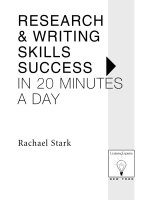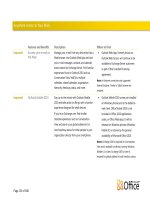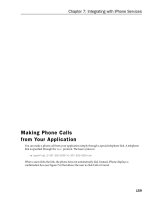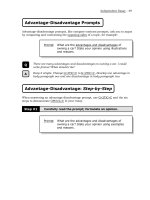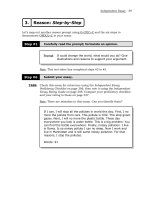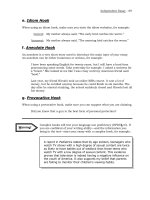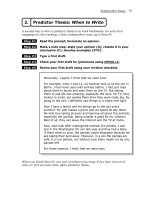Tài liệu RESEARCH AND WRITING SKILLS SUCCESS PART 14 pptx
Bạn đang xem bản rút gọn của tài liệu. Xem và tải ngay bản đầy đủ của tài liệu tại đây (84.93 KB, 7 trang )
2. STRUCTURE AND WRITING STYLE
■
Do your ideas and writing flow?
■
Are there smooth transitions from sen-
tence to sentence, paragraph to para-
graph, and from page to page?
■
Is your analysis easy to follow and
understand?
3. VOCABULARY AND TONE
■
Is your tone professional?
■
Is the writing persuasive and com-
pelling?
■
Are there any unnecessary words, sen-
tences, paragraphs, or pages that need
to be omitted or rewritten?
4. SEQUENCING
■
Are the paragraphs and sections of
your paper in the right order?
■
Are there places where information
should be changed and shifted?
5. MEANING AND CONTENT
■
What is the overall effect or lasting
impression of your work?
■
What do you want the reader to take
away after reading your paper?
Steps toward Revision
After you have gone through this initial check-
list, it becomes much easier to see which parts
of your paper you have targeted and what
areas, specific pages, paragraphs, sentences, or
words really need work. The first and most
important thing that you want to do is to
arrange all your pages one after the other, so
that they make sense. If you need to cross out
some material, go ahead and draw great big
“X’s” through any pages, paragraphs, sen-
tences, and words that impede or interrupt the
logical flow of your ideas. You next step is even
easier. Use connecting and transitional phrases
and words that you have learned to make sure
that each paragraph is linked logically to the
one above it and the one below it. If you have
trouble connecting sentences or paragraphs,
reword them slightly and see if that helps. As
far as vocabulary and tone are concerned, use
a red pen and take out or circle any conversa-
tional, slang, or colloquial words. If you need
help thinking of more formal ways to express
yourself, consult a thesaurus or synonym dic-
tionary.
The next step, sequencing, is one of the
most fun parts to correct in your paper. If you
have printed out a draft of your paper, take out
a pair of scissors. If a paragraph seems out of
place, simply cut it out and tape it where it
belongs. In fact, another good way to visualize
your paper that helps in sequencing is to tape
your pages up against the wall. Stare at them in
sequence. Do they belong in that order? If they
don’t, take a page, lift it off the wall and tape it
next to another page. If you have your draft on
a computer and prefer to work on the screen,
simply cut and paste your paragraphs wherev-
er you like.
Finally, in regard to meaning and con-
tent, pay careful attention to the end of your
paper and your conclusion. Now that you have
done all this work and are thoroughly knowl-
edgeable about your topic, writing your con-
clusion should be much easier. Your conclu-
sion, like your introduction—which included
your thesis statement—is the second most
important part of your paper. After all, your
conclusion is the last thing your reader will
see. What final impression do you want your
readers to have about your work and subject
matter? Take this time as you revise to rewrite
your conclusion. Make it perfect and look over
– REVISING YOUR DRAFT–
78
each word. Is your conclusion as powerful as it
could be?
Toward a Final Revision
The beauty of revising is that you already have
your material in front of you. You are no
longer writing from scratch, you are simply
refining and polishing. Take your time. Sit
back and read your paper from beginning to
end. Go through your checklist and allow
yourself to take the time to perfect your paper.
You can break your paper into manageable
pieces during this revision process. Look at
each paragraph and study each page. While
this task may seem time consuming and need-
lessly slow at first, remember that revising, like
writing, is a process. The more time you take
revising your thoughts, the less you will have
to edit. By thinking of the revision process as a
puzzle you are completing, you will enjoy the
challenge of putting all the final pieces into
place.
The Final Draft
When you have gone through all the steps on
the checklist and you have tinkered with all the
words, sentences, paragraphs, and pages by
changing, shifting, or rewriting them, put your
paper away in a drawer. If you can leave it for
a day or so, that’s ideal. If you are working
under a tight deadline, then just put your
paper away for a few hours. This is important.
It allows you to take some time and gain some
distance so that when you come back to your
paper to read the final draft, you can look at it
critically and with the expertise of an
informed but impartial observer. If you read
your final draft too soon after reassembling it,
you may not have adequate perspective to view
your work as a whole. After a couple of hours
or a day has passed, look at your new final
draft. Print it out and make any necessary
changes, but make sure that you keep your old
draft or drafts as well. You might need to refer
to them later. It’s always good to look at those
old drafts to see just how far you’ve come!
Summary
Revising a large work that has taken a while to
write can seem like a daunting and unpleasant
task. How do you revise a paper that has taken
so many weeks to write? Break the process
down into manageable pieces, work slowly and
systematically, and have fun. If you work on
your paper in sections, one piece at a time,
your final draft will emerge all by itself before
your very eyes.
– REVISING YOUR DRAFT–
79
81
W
hile proofreading may seem like a tedious task, being a good proofreader and critically
examining your final product is as important as writing your initial thesis statement.
There is nothing that ruins a compelling paper, article, or book more than a sloppy proofreading
job. This is ironic because proofreading is one of the simplest tasks to do well. When you proof-
read, you should keep the following criteria in mind. You are reading your paper over to check for
these four basic problems:
1. common spelling mistakes
2. grammatical errors
3. citation errors
4. informational errors
Proofreading
and Editing
Your Draft
LESSON SUMMARY
Congratulations! You have done a lot of hard work and are now
entering the home stretch. This means you are ready to add the
finishing touches to your paper. The bulk of your thinking and intel-
lectual work is done, and now you can enjoy the fruits of your
labor as you polish your writing to make it perfect. This chapter will
discuss the last steps that you need to take to get your paper into
top shape.
17
Spelling Errors
Spelling errors are the easiest and quickest
errors to detect. No one is a perfect speller, but
there are many ways to insure that the words
you have used throughout your paper are
spelled correctly. The first and quickest way to
check for spelling errors is to run a spell check
on your computer. This program instantly
enables the computer to scan through the
entire paper and point out obvious spelling
errors. But be careful, however, when you use a
computer. Computers do not check the mean-
ing of words in context. In other words, you
may write a sentence that states:
Example: President Kennedy was always their
for his advisors whenever they summoned a
Cabinet meeting to determine national policy.
The computer will see the word “their”
and will not highlight the word since it is
spelled correctly—it is the context in which it
is used that is wrong. In order to avoid gloss-
ing over these mistakes, it is a good idea to re-
read your paper after the computer has run its
check to make sure that you have used the cor-
rect word in context. As old-fashioned as this
sounds, it also helps to have an actual diction-
ary on hand. Looking up words in a dictionary
forces you to sort through physical pages and
see a word. Seeing the word in print will actu-
ally help you remember the correct spelling of
that word much more than if you simply rely
upon the computer and the click of a button.
Similarly, an excellent way to proofread is to
give your paper to a friend or relative. It always
helps to have another set of eyes reading your
work. Since you have probably spent days if
not weeks writing and researching your paper,
you may not be able to see it as objectively or
carefully as someone who is reading it for the
first time.
Grammatical Errors
Grammatical errors can be trickier to detect
than spelling errors. Again, most computers
highlight sentences that are awkwardly con-
structed or defy common rules of grammar,
but computers don’t catch everything. Use the
grammar check on your computer and then,
once again, reread your paper. You should
check your paper for:
1. grammatical agreement between sub-
jects and verbs
2. consistent use of tenses
3. sentence fragments
4. awkward phrases or construction
5. run-on sentences
Again, once you have combed through
your work, give it to a friend. Any sentence that
doesn’t make sense, that doesn’t stand on its
own with a proper subject and verb, that is
obtuse or off topic, or that continues for over
four lines, should be reworded or omitted.
Similarly, make sure that all the verbs you use
are also written in the same tense, as in this
example:
Example: Whenever President Kennedy
summoned [past tense] a Cabinet meeting his
advisors were [“to be” verb, past tense] quick
to respond.
– PROOFREADING AND EDITING YOUR DRAFT–
82
– PROOFREADING AND EDITING YOUR DRAFT–
83
Citation Errors
As you prepare your paper for footnotes, end-
notes, or parenthetical citations, it is impor-
tant to make sure that you have documented
your sources. You should have correctly copied
down all the titles, authors, publishing compa-
nies, dates of publication and page numbers
for the facts that you have listed in your paper.
Since it is not likely that you will have your
resource books with you any longer, go back to
your handy stack of note cards where you orig-
inally jotted down your information. As you
transfer information to your footnotes, end-
notes, or parenthetical citations, be sure that
you have spelled each author’s name correctly
and that all the accompanying information is
also correct. Although it is extraordinarily
unlikely that a living author or publishing
company executive will read your paper and
sue you for incorrect information or spelling
of a name, it is essential when documenting
your sources and facts to make them accurate.
Remember, your paper might be an important
source of information for others and as a pro-
fessional work that is also educational, it must
be accurate. Now is an ideal time to catch any
errors before you incorporate this information
into the final footnotes and bibliography.
Informational Errors
Finally, before your paper is submitted, check
it once again for accuracy. Are you sure that all
your facts came from reputable sources that
you can quote and document? Is there any
material or analysis that could be incorrect or
that you can’t substantiate? While your paper
may not be officially published or even used as
a reference for others, it is still your product
and as your product, it is ultimately a reflec-
tion of you. Your argument and analysis will
lose all credibility if you have used bogus
sources or have falsified or altered any infor-
mation to fit your thesis. You may also face
charges of plagiarism, which is considered a
serious offense by schools and universities, and
is against the law.
Editing
Now that you have gone through your paper
with a fine-tooth comb and have corrected all
errors and inaccuracies, this is the ideal time to
make any additional edits. Since you have your
work in its final form, this process should be
easy. Take out a marker or pen—in any color
that will stand out from the original text. Get
ready to circle specific words or cross out any
last paragraphs or pages that you feel do not fit
your paper. In this last editing stage, you are
attempting to revise your paper with these
final criteria in mind:
1. brevity
2. clarity
3. continuity
Is your writing sweet, short, and to the
point, or do you repeat yourself in certain
places and passages? Are there pages that
describe or explain the same incidents and
facts? Can you make the same points with
fewer sentences and using fewer words?
Similarly, is your writing clear? Are the expla-
nations that you provide for your reader
enlightening or are they obvious to you
alone—or only an expert in that particular
field? Finally, does your paper make sense
from beginning to end? Is your writing and
narrative streamlined or is your writing chop-
py and abrupt? Can the reader easily follow
your thoughts or does he or she have to flip
back and forth between pages in order for the
writing to make sense? It is normal for you as
a writer to like what you have written. After all,
you have spent a great deal of time and effort
working on your paper, gathering sources,
making notations, writing, and editing. But be
ruthless as an editor! If there are any problem
areas or unnecessary material, take it out. It is
always better to have a shorter, more focused,
and persuasive paper than to have an overly
long, tedious, and confusing piece of analysis.
Remember that less is more!
Summary
Both the process of proofreading and editing
should be easy compared to the gathering of
research and the actual writing of the paper.
However, while these final tasks may be easier,
they are equally important. A valuable paper
and excellent piece of writing can easily be
ruined and dismissed by readers if you do not
proofread for basic spelling and grammatical
errors. In addition, although you may feel as if
you have sweated and labored over every word
and each sentence, cut out any phrases, para-
graphs, or pages that are not necessary or do
not add to your work. While you may feel as if
you are taking a knife to your creation, in real-
ity, you are being merciless in your detection
of errors. Now your paper, your work, and
ultimately your reputation, are the best that
they can be.
– PROOFREADING AND EDITING YOUR DRAFT–
84
